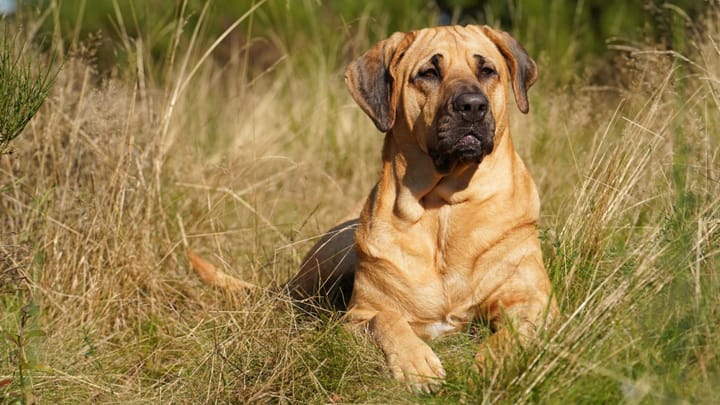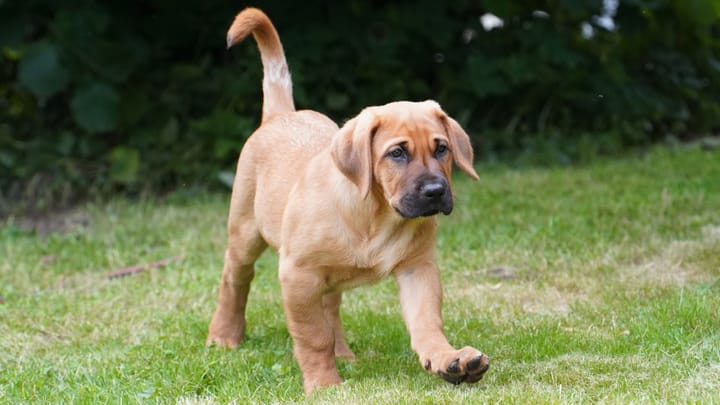Broholmer
Other names : Danish Mastiff, Danish Broholmer, Gammel Dansk Hund, Old Danish Dog, Dog of Frederick VII


This large Broholmer breed hails from Denmark, where it was often employed as a watchdog in wealthy homes. In Copenhagen, around the 1800s, he was nicknamed the “butcher’s dog” as he would frequently be discovered lying on the steps of the butchers’ shops. Previously, the Broholmer would be used as both a herder and a watchdog, yet even today, he is still a lovely dog to be around children, regardless of his large size.
|
Life expectancy |
The Broholmer has a life expectancy of between 10 and 12 years |
|
Temperament |
|
|
Size |
Large
|
|
Adult size |
Female
Between 27 and 28 in
Male
Between 29 and 30 in
|
|
Adult weight |
Female
Between 88 and 132 lb
Male
Between 110 and 154 lb
|
|
Coat colour
Black, light or brownish yellow. |
Black Red Sand |
|
Type of coat
Smooth and short. |
Short |
|
Eye colour
Amber. |
Brown
|
|
Purchase price |
The Broholmer costs between £700 and £1000 |
If the Broholmer bitch has puppies, the litter size can be between 4 to 10 pups. As this is a large-sized dog, it may take some time for the puppies to reach full-size. Because of this, it’s important not to over-exercise or do any strenuous activities that might cause damage to your pup’s joints which are still developing.
More details about the Broholmer
Broholmer: Origins and history
The Broholmer’s ancestors can be traced back as far as the Middle Ages, when these dogs were used for stag hunting. Although there is little documented about this breed, it originated in Denmark and is nicknamed the Danish Mastiff. The Broholmer is actually a cross-breed between a local German breed and an English Mastiff. The dog was named after an 18th century gamekeeper, Sehested of Broholm. During the 19th century, the breed was very popular in Denmark, but then became almost extinct during the Second World War. The Broholmer breed was imported into the UK in 2009.
Physical characteristics of the Broholmer
A mastiff type, the Broholmer is a large sized dog, very well-muscled. He has a stance of dominance and power. This dog has a wide head and a broad, deep chest. The Broholmer has some loose skin, particularly around his neck region.
FCI classification of the Broholmer
-
Group 2 - Pinscher and Schnauzer - Molossoid and Swiss Mountain and Cattledogs
-
Section 2 : Molossian type
Broholmer: Characteristics
Broholmer: Behaviour
Training a Broholmer
An intelligent dog that responds well to strict training routines. Early socialisation training for a young puppy is recommended.
Broholmer: Lifestyle
Breed compatibility Broholmer
Broholmer: Purchase price
Expect to pay an initial purchase price of between £700 to £1000 for a Broholmer puppy. Add to this cost a monthly amount of between £80 to £100.
Broholmer: Shedding
Average
These dogs are heavy seasonal shedders. The Broholmer sheds his undercoat a few times each year.
Broholmer: Grooming
The Broholmer, even though he has a short coat, has a dense undercoat. Weekly brushing should suffice, apart from times when he is shedding, when you will need to do this daily. It’s wise to begin grooming practices from an early age, so this large dog will be accepting of all grooming procedures.
Broholmer: Health
In most cases, the Broholmer isn't prone to major health issues. Due to his large size, he may be susceptible to musculoskeletal conditions such as elbow or hip dysplasia. Because of this, it is advisable not to allow your puppy to run long distances until his joints are fully developed. The average life expectancy for this breed is 11 years.
This large dog is well muscled and very strong. He displays great power and dominance.
As this canine has a dense, thick coat, during periods of hot weather he needs ample shade in his living quarters. The Broholmer is very sensitive to high temperatures.
The Broholmer tolerates chilly weather but not freezing temperatures.
As a large dog who needs more than an average amount of nutrition to meet his needs, likewise, his daily exercise must be sufficient to prevent him from becoming overweight.
- Hip and elbow dysplasia
- Arthritis
- Entropion ectropion
- Progressive retinal atrophy
- Cataracts
- Heat sensitivity






